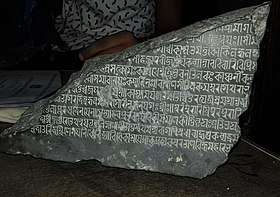Gaudi script
The Gaudi script is the ancestor of Bengali alphabet. It was first used to write Prakrit and Sanskrit.[1][2]
| Gaudi script | |
|---|---|
 Sample of the 12th century Tirhuta, which was thought to be given rise to by 10-14th century Gauḍi according to [Salomon 1998]. | |
| Type | |
Time period | c. 900-1300 CE [1] |
Parent systems | Proto-Sinaitic alphabet[a] |
Child systems | Bengali alphabet |
Sister systems | Kamarupi script, Tibetan script, Nagari script |
[a] The Semitic origin of the Brahmic scripts is not universally agreed upon. | |
Origins
The Gaudi script appeared in ancient India as a far-eastern variant of the Siddham[1], derived from Gupta.
gollark: NO!
gollark: But yes, it might be hard in CC itself.
gollark: They could also make a web frontend.
gollark: I assumed they would at least want emphasis or something.
gollark: But in general Markdown has weird features which interact in weird ways, and if you can get away with it, some HTML-type thing is probably easier since it's at least consistent (not actual HTML5).
See also
- Brahmi script
- Brahmic scripts
- Siddham
- Eastern Nagari
- Lipi
References
- Salomon, Richard (1998). Indian Epigraphy. p. 41.
- Handbook of Literacy in Akshara Orthography, R. Malatesha Joshi, Catherine McBride(2019), p.27, Peter T. Daniels, Indic Scripts: History, Typology, Study
This article is issued from Wikipedia. The text is licensed under Creative Commons - Attribution - Sharealike. Additional terms may apply for the media files.